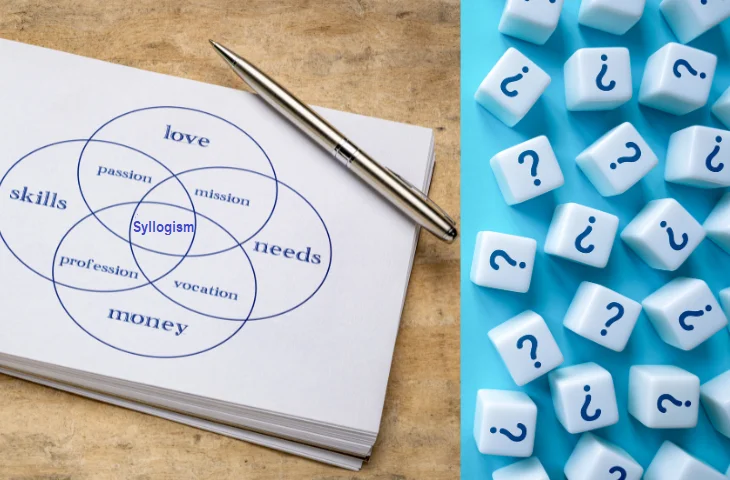Syllogism is an interesting topic in logical reasoning. Syllogism questions are often easy but tricky to solve. These types of questions, if answered correctly, are less time-consuming and scoring. However, identifying the correct answer is the real trick. In this blog, we have provided all the details about Syllogism strategies, concepts, tips and Syllogism tricks to answer these questions correctly in one go.
What Is Syllogism in Reasoning?
Syllogism is a type of logical reasoning question where you are given a set of statements and asked to determine which conclusions logically follow from them.
These questions are frequently asked in competitive exams to test a candidate’s deductive reasoning skills. Candidates need to understand the relationships between the given statements and use logic (not assumptions) to arrive at valid conclusions.
Skills Required:
- Deductive logic
- Statement interpretation
- Visual reasoning (Venn diagrams)
- Elimination technique
Why Are Syllogism Questions Important in Competitive Exams?
These types of questions are mainly used to assess an aspirant’s thinking and understanding skills. They are tricky, as sometimes candidates are not just asked which conclusions follow, but also which conclusions do not follow to confuse them in the exam hall. The number of questions from this topic asked in various exams is as follows:
| Exam | No. of Questions | Difficulty |
| SSC CGL / CHSL | 1-2 | Easy |
| IBPS PO / SBI PO | 2-3 | Moderate |
| RRB NTPC / Group D | 1 | Easy |
| State PSC / Police | 1-2 | Moderate |
Syllogism is a scoring topic and can be solved in under a minute with proper techniques. It is also part of Logical Reasoning in many state and national-level exams.
Terms Used in Syllogism Questions
There are various terms used in syllogism questions. The details of the terms most commonly used in the exam are as follows:
| Term | Meaning |
| Premise | A given statement (e.g., All A are B) |
| Conclusion | Deduction based on premises |
| Universal Positive | All A are B |
| Universal Negative | No A is B |
| Particular Positive | Some A are B |
| Particular Negative | Some A are not B |
| Venn Diagram | Diagrammatic tool used for visualizing logical relations |
| Complementary Pairs | Pairs like “Some A are B” and “Some A are not B” (can both be false) |
Also check: Number Series Questions
Tricks to Be Followed to Solve Syllogism
There are various key concepts that aspirants must keep in mind while solving this topic. The details of the tricks that candidates must follow while solving syllogism questions are as follows:
| Concept | Explanation |
| Universal Statements | Begin with “All” or “No”; have broader validity |
| Particular Statements | Begin with “Some”; limited validity |
| Basic Diagrams | A → B (All A are B), A × B (No A is B), etc. |
| Immediate Conclusion | Derived without combining multiple premises |
| Mediate Conclusion | Combines two or more statements |
| Either–Or Case | Occurs when both conclusions are wrong individually but one must be true |
What Are the Types of Syllogism Questions in Reasoning?
Types of questions that are mostly asked in the exam are as follows:
| Type of Syllogism | Key Features | Simple Example |
| Basic / Standard Syllogism | Direct statements with definite conclusions. Answer must be 100% true. | Statement: All cats are animals. Conclusion: All cats are animals – True |
| Either–Or Syllogism | Two conclusions are given; both cannot be true together but one must be true. | Statement: Some pens are pencils. Conclusions: (1) Some pens are not pencils. (2) All pens are pencils. – Either (1) or (2) is true |
| Coded Syllogism | Uses symbols/letters to represent statements; must decode before solving. | If A # B = All A are B If A @ B = Some A are B |
| Sequential Syllogism | Multiple statements connected in a chain; conclusion follows step by step. | Statement 1: All dogs are animals. Statement 2: All animals are living beings. Conclusion: All dogs are living beings – True |
Syllogism Formulas for Reasoning
These are the logic that aspirants must apply while solving the reasoning questions, the details of the formulas are as follows:
- All A are B – Some B are A (Possibly True)
- No A is B – No B is A (Definitely True)
- Some A are B – Some B are A (Possibly True, Not Always True)
- All A are B + All B are C – All A are C
- All A are B + No B is C – No A is C
Also check questions based on Clock Reasoning
Syllogism Tricks for SSC CGL, Bank PO and Other Exams
Some of the common tricks that candidates must always use to solve syllogism questions are as follows:
- Use Venn diagrams for accuracy
- Avoid assumptions – only trust what’s given
- Eliminate invalid conclusions first
- Use “complementary pair” logic for either–or
- Revise symbol-based codes regularly
- Practice reverse testing (assume conclusion and check statements)
- Mark conclusions as True, False, or Can’t be determined
Solved Syllogism Questions from 2024–25 Exams
Some of the types of questions that are asked in the examination are as follows:
Question 1
Exam: SSC CGL 2024 Tier 1 (Shift 2 – Memory-Based)
Statements: All books are pens. Some pens are papers.
Conclusions:
I. Some papers are books.
II. All pens are books.
Answer: Neither follows
Explanation: No direct link between books and papers. All pens being books contradicts the first statement.
Question 2
Exam: IBPS PO Prelims 2024 (Memory-Based)
Statements: No fruit is vegetable. All vegetables are green.
Conclusions:
I. No fruit is green.
II. Some green are vegetables.
Answer: Only Conclusion II follows
Explanation: “No fruit is green” is not directly inferred. But “Some green are vegetables” is definitely true.
Question 3
Exam: SBI Clerk 2025 (Memory-Based)
Statements: All dogs are animals. Some animals are cats.
Conclusions:
I. Some dogs are cats.
II. All dogs are cats.
Answer: Neither follows
Explanation: No direct relationship established between dogs and cats.
Tips to Solve Reasoning Questions
Some common terms frequently asked in reasoning syllogism questions, along with tips on understanding these terms and the process to solve questions based on them:
- Definite Conclusion Rule: If a definite conclusion is false in any of the possible diagrams, it is considered false.
- Positive and Negative Statements: If all statements are positive, then all negative conclusions will be false in definite cases, and vice versa.
- Complementary Pair “Some + No”: For this pair, the subject and predicate can be interchanged when analyzing conclusions.
- Either-Or Case Rule: If two conclusions have the same subject and predicate and form a complementary pair but only one conclusion is true, it does not form an either-or case; “Some + Some” is not valid.
- Possible Conclusion Rule: If a possible conclusion is true in any one of the possible diagrams, it is considered possibly true.
- “Only a Few” Meaning: The phrase “Only a few” indicates that both conclusions are definitely true, e.g., “Some A are B” and “Some A are not B.”
- Valid Complementary Pairs for Either-Or: In either-or cases, the valid complementary pairs are “Some + No” and “All + Some not.”
- Subject and Predicate Consistency: Both conclusions should have one of the valid complementary pairs; subject and predicate must remain the same and cannot interchange; the answer is usually “Can’t say.”
- General Rule for Candidates: Always follow these rules carefully while solving syllogism questions to improve accuracy and reduce mistakes.
Syllogism Concepts for Bank Exams
Bank exams like IBPS PO and SBI PO often test syllogism with symbolic logic. Example:
Statement: A % B means “All A are B”; A $ B means “No A is B”
If P % Q, Q $ R, then
Conclusion: No P is R – Follows
You need to decode symbols and apply logical templates to arrive at answers.
Common Mistakes to Avoid while Solving Syllogism
While solving syllogism reasoning questions, candidates must keep the below-mentioned details in mind:
- Assuming Unstated Information: Drawing conclusions that are not explicitly mentioned in the statements.
- Confusing “Some” with “All”: Misinterpreting “Some A are B” as “All A are B” or “Some B are A”.
- Ignoring Venn Diagrams: Not using visual tools like Venn diagrams, which help validate conclusions clearly.
- Incorrect Use of Either–Or Logic: Applying either–or when the conclusions are not mutually exclusive and independently false.
- Using Intuition Over Logic: Relying on guesswork instead of logical reasoning leads to incorrect answers.
What Are Related Topics I Should Revise Next?
Topics you should revise next are as follows:
- Questions based on Direction Sense
- Rules and Practice Questions of Coding-Decoding
- Shortcuts and Tricks to solve Floor Based Puzzle
- Various types of Blood Relations Questions
- Tricks & Examples of Seating Arrangement
FAQs
Use Venn diagrams for visual clarity, memorize standard logic rules, and practice “either or” conditions to reduce time.
Common forms include direct verbal syllogism, coded symbol-based questions, either–or conclusions, and mixed statement types.
Use Venn diagrams, avoid assumptions, eliminate false conclusions, decode symbols properly, and practice regularly to master it.
They use codes/symbols in place of statements. You must decode and apply logic accordingly.
Break them down step by step, use short-hand diagrams, and analyze one conclusion at a time for clarity and speed.
- SSC CGL 2025 Tier 1 Question Papers, Shift-Wise PYPs, Download PDFs
- Delhi Police Vacancy 2025, Check Exam wise vacancies
- Punjab and Sind Bank LBO Result 2025 Out, Download PDF
- IBPS PO Mains Scorecard 2025 Out Soon, Check and Download Marksheet
- SSC CGL Tier 2 Study Plan 2025 for Last 15 Days Before Exam
- SBI SCO Salary 2025, In Hand Salary, Perks and Allowances

Hello there! I’m a dedicated Government Job aspirant turned passionate writer & content marketer. My blogs are a one-stop destination for accurate and comprehensive information on exams like Regulatory Bodies, Banking, SSC, State PSCs, and more. I’m on a mission to provide you with all the details you need, conveniently in one place. When I’m not writing and marketing, you’ll find me happily experimenting in the kitchen, cooking up delightful treats. Join me on this journey of knowledge and flavors!
